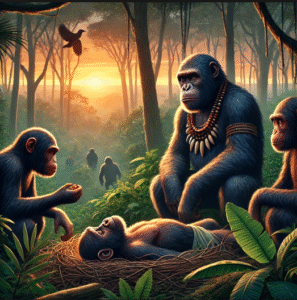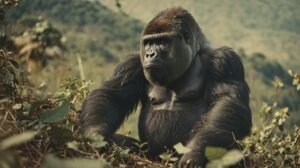King of the Planet of the Apes: A New Era Unfolds
Introduction: A New Generation Begins
The opening scene sets a somber tone as Caesar, the iconic leader of the apes, passes away. His fellow apes gather around his body, preparing for a traditional ceremony to honor him. The peaceful moment transitions into the appearance of three young apes—Soona, Noa, and Anaya—who emerge as central characters. As they climb through the forest, their personalities begin to shine. Noa, the cautious and thoughtful male ape, expresses skepticism about an elder named Luna, while Soona, the wise and protective female, assumes a leadership role. The trio’s journey is quickly set in motion as they discover bird eggs, a subtle foreshadowing of the challenges to come.
Opinion
The opening sequence masterfully reminds the audience of Caesar’s death while transitioning into a new generation of characters. Noa’s cautious nature, Soona’s leadership, and Anaya’s more subtle presence create an intriguing dynamic that hints at future conflicts. The introduction of these three apes feels fresh, though Noa stands out as a central figure from the start.

The Valley of the End: A Forbidden Place
In a suspenseful turn, the apes find themselves near a forbidden cave, the “Valley of the End,” a mysterious place filled with danger and uncertainty. Their retreat from the area signals the start of an adventure fraught with peril. Back in their village, the young apes are welcomed as heroes, but tension builds as they grapple with their decisions and encounters. Soona’s interaction with the younger apes reveals her fiercely protective nature, further defining the trio’s dynamic.
Opinion
The Valley of the End brings an air of mystery that hooks the audience early on. It sets up the notion of taboo places that apes are warned not to visit, a classic element that adds depth to their society. Soona’s leadership and Noa’s caution blend well, though Anaya seems less prominent at this point. It’s clear that this forbidden valley will play a major role later in the story, keeping viewers intrigued.
Family and Tradition
Noa’s interactions with his family provide deeper insight into the values and traditions of the apes. His father, Kora, a stern but caring figure, senses that Noa has ventured into forbidden territory, sparking a pivotal moment of tension and trust. This scene lays the groundwork for the family-centric narrative, showing the significance of tradition in their society.
Opinion
Kora’s protective nature adds a layer of tension between tradition and rebellion. This father-son dynamic feels authentic, showing how Noa’s journey will challenge the values he’s grown up with. It’s an essential moment that hints at the internal struggles Noa will face throughout the film.
An Unexpected Encounter
Noa’s world is turned upside down when he encounters a human girl, who inadvertently smashes a precious egg. This act introduces a new layer of conflict between the apes and humans, showcasing the delicate balance between the two species. The subsequent scenes build on the growing tension, as Noa and his companions navigate the complexities of their world.
Opinion
The human girl’s entrance adds an unexpected twist, reminding us that this isn’t just a story about apes but also about the fragile relationship between apes and humans. The broken egg symbolizes how easily peace can be disrupted, and Noa’s reaction shows the first glimpse of deeper stakes in the plot.

The Rise of Sylva: An Antagonist Emerges
The introduction of the antagonist, Sylva, brings a darker tone to the story. Sylva, the ruthless ape leader, is fixated on capturing the human girl, sparking a series of violent attacks on Noa’s village. The brutal destruction of their home sets the stage for an intense showdown between Noa and Sylva, as well as the internal struggle within Noa as he grapples with his role in the chaos.
Opinion
Sylva’s entrance is chilling, setting him up as a formidable villain. His motivation to capture the human girl adds complexity, but his willingness to destroy his own kind makes him an even more compelling antagonist. The ensuing destruction of the village pushes Noa into action, raising the emotional stakes significantly. The showdown between Noa and Sylva is inevitable, and it keeps the audience on edge.
A New Journey: The Search for Answers
After the destruction of his village, Noa embarks on a journey to find answers, leading him to a mysterious figure named Raka. Raka introduces Noa to the history of Caesar and the deep connection between apes and humans. This exploration of the past adds depth to the narrative, revealing the ideological divide between the two species and setting up the broader conflict.
Opinion
Raka’s character adds much-needed depth and wisdom to the story. His knowledge of Caesar and the past creates a bridge between the original Planet of the Apes saga and the new generation, which is a great way to connect long-time fans with this new narrative. Noa’s reaction to the stories of Caesar shows how deeply these legends impact the current generation.

The Vault and the Battle for Survival
As Noa and his companions delve deeper into their quest, they discover a vault containing remnants of a lost human civilization. The suspense builds as Mae, the human girl, reveals her role in a larger plan. The vault becomes the focal point for a climactic battle, where alliances are tested, and the fate of both apes and humans hangs in the balance.
Opinion
The vault symbolizes the unknown past and holds secrets crucial to both apes and humans. The tension rises as Mae’s intentions become clearer, but it’s the confrontation that truly grips the audience. The balance between action and suspense is well-maintained, although some characters could have been explored further during this sequence.
Final Showdown: Noa vs. Sylva and Proximus
The final confrontation between Noa and the two key antagonists—Sylva and Proximus—delivers a satisfying conclusion to the film’s central conflicts. Sylva’s demise is dramatic, and the battle between Noa and Proximus serves as the emotional peak of the story. Noa’s growth from a hesitant young ape to a leader in his own right is fully realized, symbolized by his connection to the eagle, a recurring motif throughout the film.
Opinion
Sylva’s defeat is expected but nonetheless satisfying, and the battle with Proximus feels like the true climax. Noa’s transformation into a confident leader is the most rewarding part of the movie, making the journey worthwhile. The eagle motif adds a beautiful symbolism of freedom and leadership, tying Noa’s character arc together seamlessly.
Rebuilding and Reflection
The film concludes on a hopeful note, with Noa and his fellow apes beginning to rebuild their home. The themes of leadership, sacrifice, and the uneasy relationship between apes and humans are woven throughout, leaving audiences with a sense of closure, while also hinting at future challenges.
Opinion
The rebuilding scene closes the movie on a reflective note, allowing the audience to appreciate Noa’s growth and the apes’ resilience. While the film doesn’t reach the epic heights of the earlier Planet of the Apes movies, it does lay the groundwork for future installments. The underlying tension between apes and humans remains unresolved, leaving the door open for more exploration in sequels.
Conclusion: A Legacy Continued
King of the Planet of the Apes delivers a powerful message about legacy, trust, and the importance of unity in the face of adversity. While the film doesn’t reach the heights of its predecessors, it serves as a compelling continuation of the Planet of the Apes saga, introducing new characters and themes while paying homage to the legacy of Caesar. Noa’s journey, marked by moments of doubt, bravery, and self-discovery, is a worthy addition to the series.







